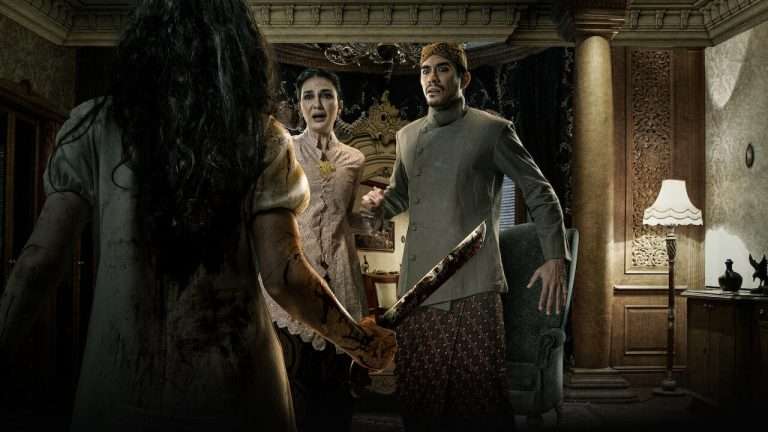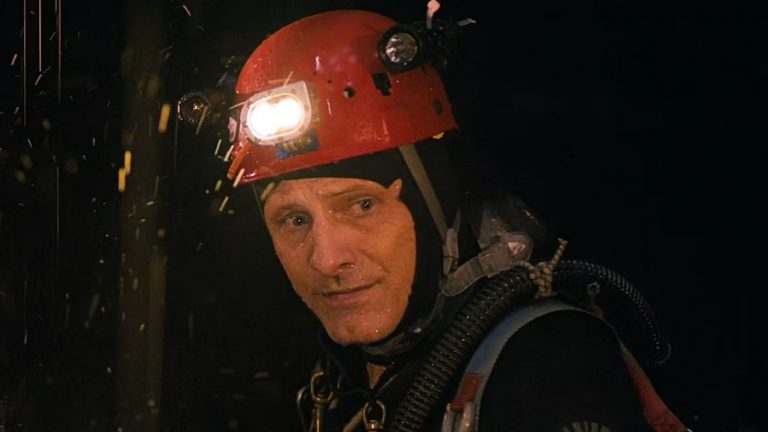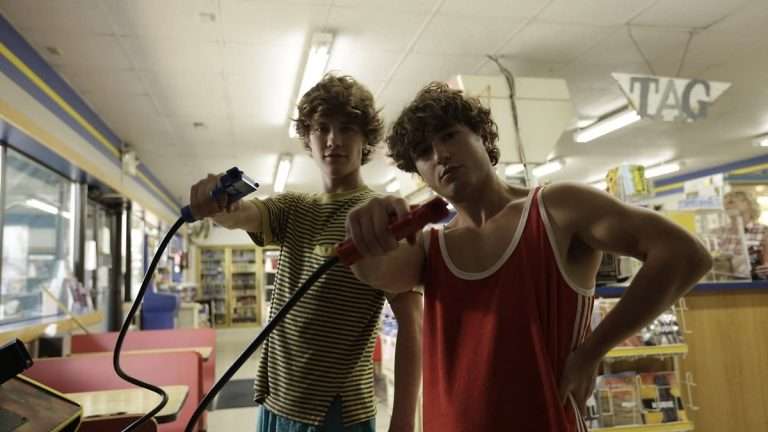Crimes of the Future (2022) Movie, Ending Explained & Themes Analysed: Who would have thought that Cronenberg’s dystopian and cerebral science-fiction would speak so vociferously of artistic transcendence— a subject which eludes even the poets— through abject corporeal horror? Teeming with explicit visuals of the autopsy on the dead or the living, this Cannes 2022 feature pushes the boundaries of what is accepted as ‘human.’ Cronenberg is widely known as one of the prime precursors of ‘body horror‘ — a genre that exhumes the ephemeral nature of the human body by often incorporating perverse elements that culminate into an existential disquiet. After almost a decade, he returns with ‘Crimes of the Future (not a remake of his 1970 film of the same name), where he strives to redefine the grotesque and the aesthetic and bags a six-minute standing ovation at the Cannes premiere.
Speculations of gruesome bodily transitions have always lurked in the consciousness of man. In mythology, numerous instances of the human body paving the way to monstrosities can be found. Over a hundred years ago, the timeless author Franz Kafka wrote the story of a man who wakes up one fine day, only to realize that his body has been transformed into an insect. Most of the novella then goes on to delineate his struggle to get out of bed, ingest food, or accept himself by his family. At the heart of these fabled transmutations lies an almost tactile dread of the unknown. This dread is also the ground on which Cronenberg builds his dystopian future world. The grimness that each frame is saturated with brings about a hopeless unease and a harbinger of impending anarchy.
Disgust is a currency that the film often deals in. It cuts deep into layers of prejudices and is a principal spokesperson for the leitmotifs. This feeling of unsettlement that is exuded from the viewer is a rebellion in itself and challenges institutional ideas. Would you call extracting an organ out of a living man’s body art? Or, would deep lacerations in the face, instead of make-up, ever be a fashion trend? The philosophical underpinning of the narrative form is not quite different from that of the works of Picasso or Duchamp, whose names appear in the course of a few dialogues. Through this essay, I intend to bring together the visual, verbal, and thematic elements incorporated in the film in an attempt to explore the statements of subversion that might have been put forth in the process.
It should be noted that this article closely draws from and also provides a synopsis of the plot, and reading this before watching the film might disrupt the element of suspense maintained throughout the storyline.
Related to Crimes of the Future – The 6 Best Body Horror Movies of All Time
CRIMES OF THE FUTURE MOVIE PLOT SUMMARY, SYNOPSIS AND CRITICAL ANALYSIS OF THEMES
PART 1: SEX AND THE NEW CITY
In a not-so-distant future, evolution separates man from man, as religion does in the present world. In this world, human beings have already mutated to a state where they are not susceptible to pain or infections anymore. This seems to have drastically affected the social as well as political landscapes and has paved the way for cultural depravities. The government has ruled out evolution as a natural phenomenon. It is socially perceived as an aberration or a disease, and there are technological solutions proposed for the disorders. Yet, in the underworld, there are militant groups who not only talk openly about their anatomical alterations but celebrate them as art and seek meaning in them.
The plot of Crimes of the Future opens with the pathos of a little boy, killed in his sleep by his own mother, who is horrified by his unnatural eating habits. The mother, Djuna Dotrice (Lihi Kornowski), cold and unfazed, somewhat relieved, then reports the murder to her husband, Lang Dotrice (Scott Speedman), who comes by the corpse of his son and is devastated.

In a dingier and livelier part of the city resides the performance art duo Saul Tenser (Viggo Mortensen) and Caprice (Lea Seydoux). Tenser suffers from ‘accelerated evolution syndrome’—a disorder that generates novel organs in his body, foreign to human existence. His condition causes him to experience pain in his sleep, the mitigation of which necessitates resting in a gargantuan bed resembling an alien womb manufactured by a government-controlled technological company. He also suffers from an eating disorder and is dependent on an elaborately constructed chair (also harrowing in appearance) for processing his food.
Caprice is Tenser’s partner-in-crime, an artist who makes art out of surgery, and also a tattooist who inks not the surface of the skin but that of organs. Together, they make a public exhibit of excavating Tenser’s nascent organs out of his body— the performances of which are cherished far and wide. Overwhelming, right? Cronenberg’s futuristic world sure takes some getting used to. His manner of socio-political discourse is naked and unflinching and does not shy away from repugnance.
The characters of Timlin (Kristen Stewart) and Whippet (Don McKellar) act as passive facilitators of the events and are introduced quite early on as officials from the National Organ Registry—a department (or almost one) that is involved in keeping records of new-found organs, in aiding the government in preventing another wave of evolution-gone-wrong. Their presence on screen is quite comical; as for them, the line between legal and illegal is often blurred, and even the judgment seems to go against their nature. They are seen in and out of illicit art shows and mingling with government officials and rogue evolutionists alike, aggravating the jitters. But, the eccentric Timlin develops a raging crush on Tenser after witnessing Caprice gut him in public using the modified version of a device meant for autopsy. At the end of the show, she approaches him with what seems like the most audacious words used in the film— ‘Surgery is the new sex’. Not much later, it is also revealed that Tenser is an undercover agent trafficking information to the evolution police, a role that even Caprice is unaware of.
Surgery is the new sex
If there is one aspect of this Cronenbergian horror that I find difficult to digest, it would be the distortion of the good old sex into versions of which even Marquis de Sade would be bashful. Possibly this is an attempt to demonstrate that both pleasure and pain are a product of neurotransmitters in our body. And though we lead our lives seeking pleasure and avoiding pain, we often do not know one from the other as they are essentially the same. Thus, the beings whose pain centers have been tampered with must feel utterly confounded in discerning what is pleasurable, resulting in a sort of biological anarchy. Naturally, the traditional sexual acts are obsolete, and only extreme acts of physical violations are found to be titillating (oral sex on internal organs is perhaps where I lost it).
How can acute body dysmorphia be called art?
Think about the infamous mural piece “Guernica” by Pablo Picasso—it is not exactly a thing of beauty, yet art critics worldwide have been pouring over it since its creation. The most sensational art pieces have rarely abided by unanimous notions of the aesthetic. But they are bestowed with an innate power to tell the flagrant truth. Sometimes they question the very premise of what qualifies as art and cause a warp in the definitive boundaries (like Duchamp’s Fountain, 1917). Caprice and Tenser’s performances and perception of those such tropes can be found in abundance. Their art is a way of probing into the personal and political truth. It is poignant because it holds up a mirror to their reality, which they are being compelled to deny or overlook. But it isn’t easy to judge whether the characters have much clarity regarding their practices. Often it seems like they are deeply conflicted beings adapting to the new ways of the world or in Caprice’s words, finding meaning in the anarchy.
PART 2: A WARNING SIGN
Cronenberg chooses not to reveal one of his major themes until the third act, and we cannot blame him for keeping a few tricks up his sleeves when such significant artistic risks are taken. The execution does not feel too abrupt, as it picks up from a plotline that the film opens with. We do get a hunch that the brutal filicide has more role to play and before long, Lang Dotrice meets Tenser with a concept for a performance.
Dotrice proposes Tenser perform a public autopsy on the corpse of his dead son—the revelation of which, according to Dotrice, will be astonishing. Tenser is intrigued by the idea and plans to dig into it further. In his explorations, he also becomes aware of a group of renegades with covert evolutionist ideas, including a former cosmetic surgeon, Nasatir and Lang. Tenser meets Djuna Dotrice in captivity and learns about her dead son Brecken’s propensities to eat and digest toxic synthetic materials. It fascinates Tenser and Caprice, as they feel that an autopsy on Brecken’s corpse would unravel the ultimate truth of evolution.
Crimes of the Future Movie Ending Explained
Tenser gets a hint of what the agenda of the evolutionists might be from an earlier visit to Timlin. Along with Caprice, he visits Lang, who divulges that he and his friends have surgically altered their digestive systems so that they can eat synthetic materials. Theirs is a rebellion that is fuelled by the belief, or rather the reality, that humans have run out of ways to dispose of the toxic wastes that they have generated over the years, and hence they must evolve to consume the same. All the eating disorders people are plagued with can only be resolved by accepting this physical destiny. And the birth of Brecken with a naturally capable digestive system was miraculous, like a universal nod of assent. Thus, Brecken’s autopsy would pave the way for that great moment when their kind steps out of the curtain.
Tenser and Caprice perform the autopsy on Brecken’s body, with several people holding their breaths. But to their utter dismay, they find that Brecken’s insides have already been shuffled beforehand, and the mess only elicits a distracting revulsion from their audience. Defeated, Lang leaves the pavilion, and two repair agents approach him from the government company that provides the bionic beds and chairs. They viciously kill him. Earlier, we have seen the same faces ambush and kill Nasatir in a similar manner. Tenser’s involvement (though unconscious) in these deaths is not challenging to work out.
Tenser learns from his police connection that Timlin had meddled with the corpse, as instructed by the government. It makes him reconsider his choices, and he refuses to be the informant. Pain keeps invading his dreams, and Caprice asks him one night to describe how it feels. As he struggles terribly with his meal the following day, Caprice suggests they try another way. She feeds him a purple synthetic bar that Lang and his friends used to manufacture and ingest. And in Tenser, the relief takes effect immediately. The camera devours his tranquil expression for a good while—an appearance of surrender to the greater forces of nature or whatever is left of it.
Environmental Awareness
Perhaps, there is no overarching concern more relevant to the world than the degradation of the environment. Yet it is not a concern that can be dealt with separately without considering the socio-political scenario at a given time. By embedding a plethora of motifs, Cronenberg has ingenuously raised a few alarming questions—questions that have long been left unaddressed by politicians, unheeded by societies, and unlearnt by scientists. His ghastly vision of a fictional, though foreseeable, future is a blow to the head that reminds you that you are still human (but might not be for long), and often a bit of fiction is easier to work with than the relentless truth.






